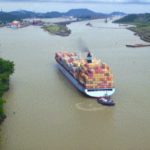AI and Big Data Analytics Reshape Demand Forecasting for Container Shipping

Fluctuating volumes, primitive tools, and unreliable commercial forecasts—the global container shipping industry faces several challenges in predicting demand. One way forward-looking logistics professionals are beginning to mitigate them is by using AI and big data analytics.
Advanced big data analytics can help collect and analyze vast amounts of data, including vessel operations, historical demand patterns, the impact of external events, and financial data. According to Lloyd’s Register’s Maritime Performance Services and their research, traditional data analytics only look at 10% of vessel data, whereas AI models can now look at close to 100% of vessel data and process this instantaneously.
This unlocks immense potential for developing more accurate demand forecasts, which can help container shipping companies make better fleet, inventory management, and even pricing decisions. Research and Markets ‘AI in supply chain management (SCM) 2023-2028’ report predicts AI in the field will reach $17.5 billion globally by 2028, with AI-enabled supply chains being over 67% more effective thanks to reduced risk and lower overall costs.
Still, forecasting container demand with AI and big data analytics is in its early stages, and there are some hurdles for the industry to overcome to succeed. Let’s dive in.
The Limitations of AI in Shipping
AI can only be as smart or effective as the quality of data provided, but data can be extensive and complex, making it difficult to analyze effectively without careful data preparation.
In 2021, a McKinsey report found close to three-quarters of supply chain executives still used manual supply-chain planning methods, with spreadsheets at the top of the list. This opens many doors for human error, and time-consuming data collection and preparation processes lead to outdated information. On top of that, shipping companies tend to operate in silos, and AI must extract data from multiple sources.
While many have a transport management system (TMS) storing container events and bookings data, a lot of critical information, such as the depot capacity, storage costs, and commercial forecasts, is still kept in multiple Excels. They may have a financial system and telematics; however, when all this collected data is siloed, there is a lack of interoperability that hinders operational and financial visibility.
No matter how good the brain is, it’s not big enough to consider all relevant factors quickly and without bias. For a more efficient picture of the future, a big chunk of the work should be automated and approved by a human qualifier.
As a result, innovators have begun to modernize, incorporating AI into their planning models, and 90% of McKinsey’s respondents said they expect to overhaul planning IT within the next five years. With all the input data automatically processed and under one roof, shipping companies can use AI and big data analytics to gain valuable insights and forecast demand.
Container Management Teams Take Charge of Demand Forecasting
One of the problems for container management teams is commercial forecasts always overestimate, resulting in piling up too many containers in certain locations—and if the area is expensive, that’s a lot of dollars spent to sit in storage.
But imagine if, instead of commercial forecasts, you could generate a separate forecast that considers historical and external data. Using actual historical data alongside external factors to fuel demand forecasting helps container managers inject precision into their planning.
With the support of big data analytics, shipping companies can assess trends across data at a granular level, discovering patterns between container bookings and locations over specific future periods. This allows them to enforce data-driven strategies to optimize their flows.
For instance, they can turn to just-in-time (JIT). This means having the right number of containers at the right time and place. Logistics providers benefit by eliminating a big chunk of the buffers they currently keep and achieving a much leaner container fleet while still satisfying 100% of the demand.
Alternatively, as JIT results in higher turn-times, it frees up containers that may be used for doing more business, or taking on additional shipments with new clients, boosting profits along the way.
By using AI and big data analytics to inform demand forecasting, shipping professionals can create more accurate predictions and mitigate the costs of overestimating equipment needs. Empowered with insights and data that can help them think outside the box, they can optimize their operations and drive business growth.
Source: By Dimitar Pavlov, Chief Growth Officer at Transmetrics
